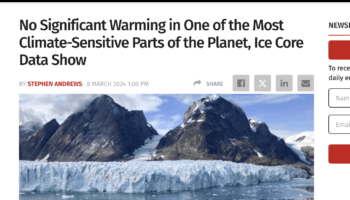- Climate
Express article falsely warns of a solar-induced "ice age"
Key takeaway
Express articles repeat this claim frequently, but research does not support the idea of imminent global cooling due to low solar activity. It is not known that a "grand solar minimum" will occur, but even if it did, the temperature effect would be much smaller than human-caused warming.
Reviewed content

Verdict:
Claim:
The current solar minimum could last for more than three decades which could lead to temperatures plummeting across the globe, scientists have warned.
Verdict detail
Inadequate support: The article quotes from a study (misidentified as published in Nature; it was actually published in Scientific Reports) but did not check with outside experts, who would have explained its key flaws. [UPDATE: That study was retracted by the journal on 4 March, 2020, for errors.]
Misunderstanding of science: A solar minimum would not cause cold weather across the globe.
Full Claim
The current solar minimum could last for more than three decades which could lead to temperatures plummeting across the globe, scientists have warned.
This article copies (in part) from previous Express stories making similar claims, such as this one previously reviewed by Climate Feedback. Similar stories from other outlets have been seen to propagate widely across the internet, despite lacking scientific credibility.
UPDATE (8 August 2019): A correction has been added to this article, and the above claim has been removed. However, while the correction states that “Northern hemisphere temperatures during [the Maunder Minimum] were reduced by 0.2 degrees C during a period of global cooling”, the article itself still states that “temperatures in the northern hemisphere dropped by 1.3 degrees celsius [sic]”. That number appears to be taken from a 2001 study, where it referred to wintertime temperatures on land (rather than an annual average for the entire Northern Hemisphere). The article still does not explain that a hypothetical grand solar minimum would only be expected to reduce human-caused global warming by about 0.1 °C.
UPDATE (19 August 2019): The article has been corrected again, removing the incorrect claim about Northern Hemisphere temperatures during the Maunder Minimum and clarifying the likely climate impact of a hypothetical grand solar minimum in the future.

Professor of Space Environment Physics, University of Reading
[This comment is taken from an evaluation of a similar statement.]
The Maunder minimum [mentioned in the article] was NOT (repeat NOT) a period of decades of freezing weather. It was a period when Europe had a higher fraction of cold winters but summers were, if anything, warmer in the Maunder minimum (as seen, for example, in the central England Temperature measurements) and paleoclimate data show a longer interval of slightly lower global temperatures (often massively misleadingly called the “little ice age”) which began long before the Maunder minimum and didn’t end until after the Maunder minimum was over. The idea that the Maunder minimum gave periods of unremitting cold is just wrong—it is often quoted but it is totally wrong.
The claimed drop of 1.3°C in the Maunder minimum is a ludicrous figure. The Figure below (from Owens et al paper1) shows any drop that could possibly be associated with the Maunder minimum is 0.2 °C (and Owes et al show that is not statistically significant). That minimum was almost 1.3 °C lower than today’s values because of 1.1 °C of anthropogenic greenhouse warming since just before and just after the Maunder minimum.

Figure – A comparison of solar activity and northern hemisphere climate from AD 800 to AD 2016. Top: Sunspot number, from direct telescopic observations (black) and reconstructed on the basis of 14C concentrations in tree trunks (red). Bottom: Northern hemisphere temperature anomaly, ΔT, (relative to the 1961–1990 mean) for paleoclimate reconstructions, as presented in the IPCC fifth assessment report. Colours, from white through red, show the probability density function (PDF), while the white line shows the PDF maximum value (or mode). The blue line shows ΔT from the instrumental record (HadCRUT4). (Source)
- 1- Owens et al (2017) The Maunder Minimum and the Little Ice Age: An update from recent reconstructions and climate simulations, Journal of Space Weather and Space Climate

Senior Scientist, Potsdam Institute for Climate Impact Research (PIK)
[This comment taken from an evaluation of a similar statement.]
While regional and seasonal effects might be larger, the expected global temperature response to a future grand solar minimum similar to the Maunder Minimum is a cooling of about 0.1°C. It should be pointed out that this cooling would occur on the background of current anthropogenic warming which is about a factor of 10 larger. To claim that temperatures will fall dramatically is thus not really justified. It is also clear from these numbers that a future grand solar minimum (which would last only for a few decades anyway) would not save us from global warming, as we have shown in a scientific paper and explained here. The marginal temperature differences between warming scenarios with and without a future Maunder Minimum is illustrated here:

Figure – Rise of global temperature for two different emission scenarios (A1B, red, and A2, magenta). The dashed lines show the slightly reduced warming in case a Maunder-like solar minimum should occur during the 21st century. The blue line represents global temperature data. Source: PIK.



